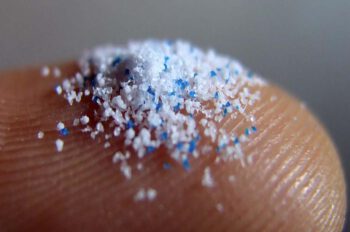Staff Writer for Wake Up World
In a startling revelation, researchers from the University of New Mexico have discovered significant concentrations of microplastics in the testicular tissue of both humans and dogs. This alarming finding adds to the growing concerns about the potential effects of microplastics on human reproductive health.
Unveiling the Invisible: Microplastics in Testicular Tissue
In a study published in the journal Toxicological Sciences, Xiaozhong “John” Yu, MD, PhD, MPH, a professor at the UNM College of Nursing, led a team that identified 12 types of microplastics in 47 canine and 23 human testicular samples. “Our study revealed the presence of microplastics in all human and canine testes,” Yu stated.
Using a novel analytical method, the researchers quantified the number of microplastics in the tissue samples, finding correlations between certain types of plastic and reduced sperm count in the canine samples.
The Bigger Picture: Environmental Factors and Reproductive Health
Yu’s research builds on previous findings about the impact of heavy metals, pesticides, and endocrine-disrupting chemicals on reproductive health. His colleague, Matthew Campen, PhD, a UNM College of Pharmacy professor, had previously documented microplastics in human placentas, prompting Yu to investigate further.
“He said, ‘Have you considered why there is this decline in reproductive potential more recently? There must be something new,'” Yu recalled. This question led to the current study’s design, which used experimental methods similar to those used in placenta research.
The Methodology: From Tissue to Discovery
The team obtained anonymized human tissue from the New Mexico Office of the Medical Investigator and canine tissue from local animal shelters and veterinary clinics. They chemically treated the samples to dissolve fats and proteins, then used an ultracentrifuge to isolate plastic particles. These particles were analyzed using a mass spectrometer, which detected different types of plastic based on their burning temperatures.
In dogs, the average concentration of microplastics in testicular tissue was 122.63 micrograms per gram of tissue. In humans, it was significantly higher at 329.44 micrograms per gram. “At the beginning, I doubted whether microplastics could penetrate the reproductive system,” Yu admitted. “When I first received the results for dogs, I was surprised. I was even more surprised when I received the results for humans.”
The Impact: Types of Plastics and Their Effects
The study found that polyethylene (PE), commonly used in plastic bags and bottles, was the most prevalent polymer in both human and canine tissue. PVC (used in plumbing and other applications) followed PE in prevalence in dogs. The team also found that higher levels of PVC in canine tissue correlated with lower sperm counts, suggesting a potential disruption in spermatogenesis.
“The plastic makes a difference — what type of plastic might be correlated with potential function,” Yu explained. “PVC can release a lot of chemicals that interfere with spermatogenesis and it contains chemicals that cause endocrine disruption.”
Shared Environment, Shared Risks
Dogs were included in the study because they share the environment and some biological characteristics with humans. “Compared to rats and other animals, dogs are closer to humans,” Yu noted. “Physically, their spermatogenesis is closer to humans, and the concentration has more similarity to humans.”
Microplastics are now ubiquitous in the environment, stemming from the degradation of larger plastic items exposed to sunlight and other elements. Wind and water can carry These tiny particles, infiltrating various ecosystems. Given the higher average age of the men in the study (35 years), the impact on younger generations, who are exposed to more plastic, could be even more concerning.
Looking Ahead: The Need for Further Research
The findings highlight the urgent need for more research to understand how microplastics affect sperm production and overall reproductive health. “We have a lot of unknowns,” Yu emphasized. “We need to really look at what the potential long-term effect is. Are microplastics one of the factors contributing to this decline?”
Despite the alarming results, Yu advises against panic. “We don’t want to scare people,” he said. We want to provide the data scientifically and make people aware there are a lot of microplastics. We can make our own choices to better avoid exposures, change our lifestyle, and change our behavior.”
Conclusion
The discovery of microplastics in testicular tissue underscores the pervasive nature of plastic pollution and its potential impact on reproductive health. As we navigate this new environmental challenge, it becomes increasingly important to understand and mitigate our exposure to these hidden threats.
Journal Reference:
- Chelin Jamie Hu, Marcus A Garcia, Alexander Nihart, Rui Liu, Lei Yin, Natalie Adolphi, Daniel F Gallego, Huining Kang, Matthew J Campen, Xiaozhong Yu. Microplastic presence in dog and human testis and its potential association with sperm count and weights of testis and epididymis. Toxicological Sciences, 2024; DOI: 10.1093/toxsci/kfae060
About the author:
John Patterson is an avid writer and researcher who delves into the latest scientific research. With an insatiable curiosity, he translates complex concepts into accessible narratives, allowing readers to embark on a journey of discovery. John bridges the gap between experts and the public through his work, igniting curiosity and inspiring meaningful conversations about scientific breakthroughs.

If you've found value in our articles, we invite you to support the release of our brand-new book, "Gratitude Practices for Kids: A Practical Guide for Adults to Instill a Spirit of Appreciation and Positivity in the Next Generation."
"Gratitude Practices for Kids" brings together over 25 innovative and accessible practices designed to enhance gratitude in everyday life. This comprehensive guide is backed by 17 scientific studies, ensuring each concept is grounded in research, underscoring our commitment to nurturing growth, emotional intelligence, and positive interactions between adults and children.
We encourage you to opt for the paperback version to celebrate this new release. Dive into its fresh pages away from digital distractions, allowing you to immerse yourself in the transformative practices it offers.
Over recent years, Wake Up World has faced significant online censorship, which has impacted our financial ability to operate. Moving into book publishing represents a strategic step to secure the ongoing funds needed to continue our mission. By purchasing Gratitude for Kids, you help us keep our content free and accessible to everyone, avoiding needing a paywall. With over 8,500 articles published in the last 13 years, we remain dedicated to keeping our valuable content open to all.







